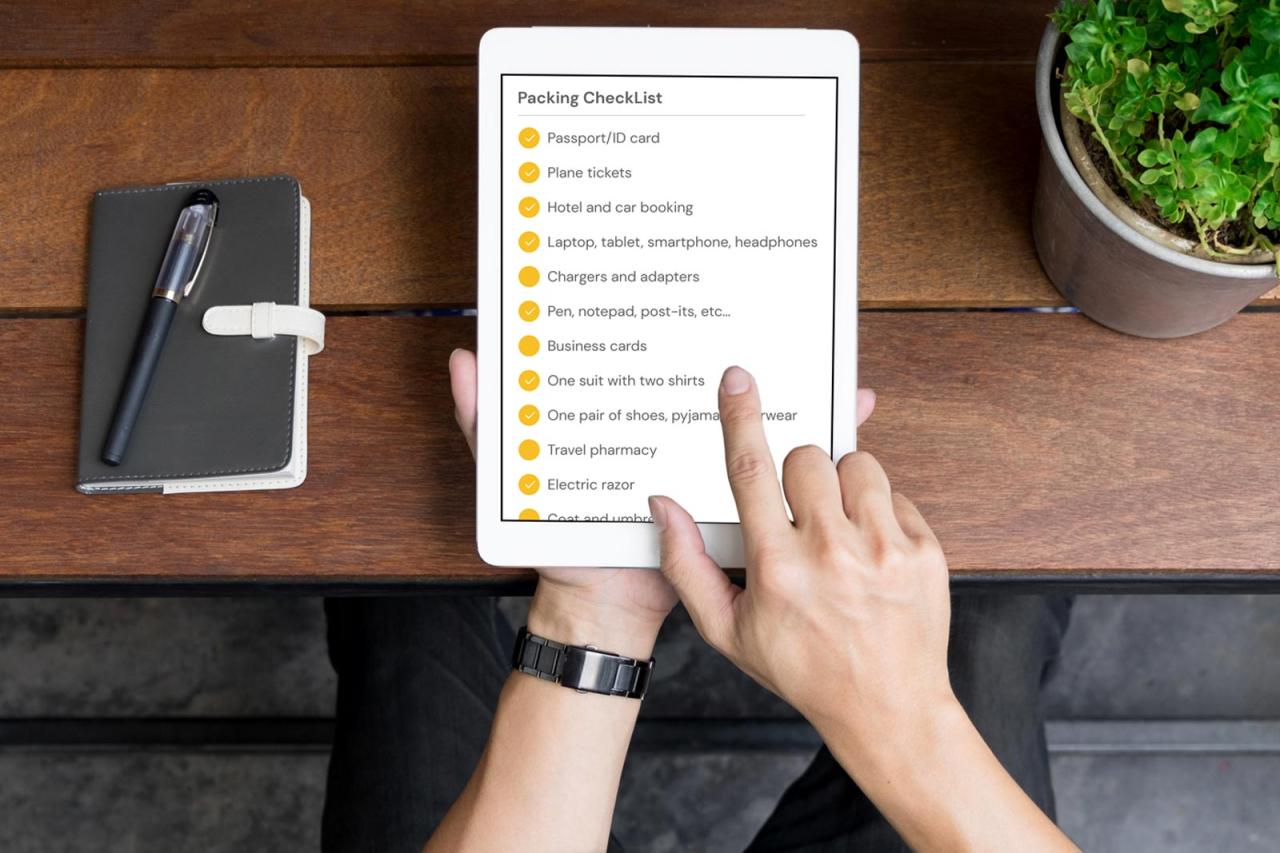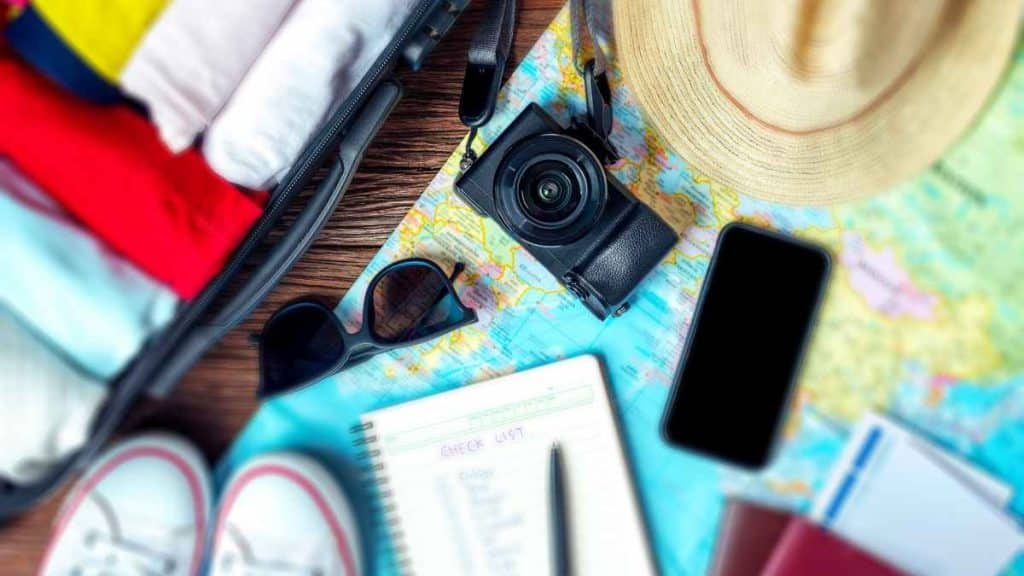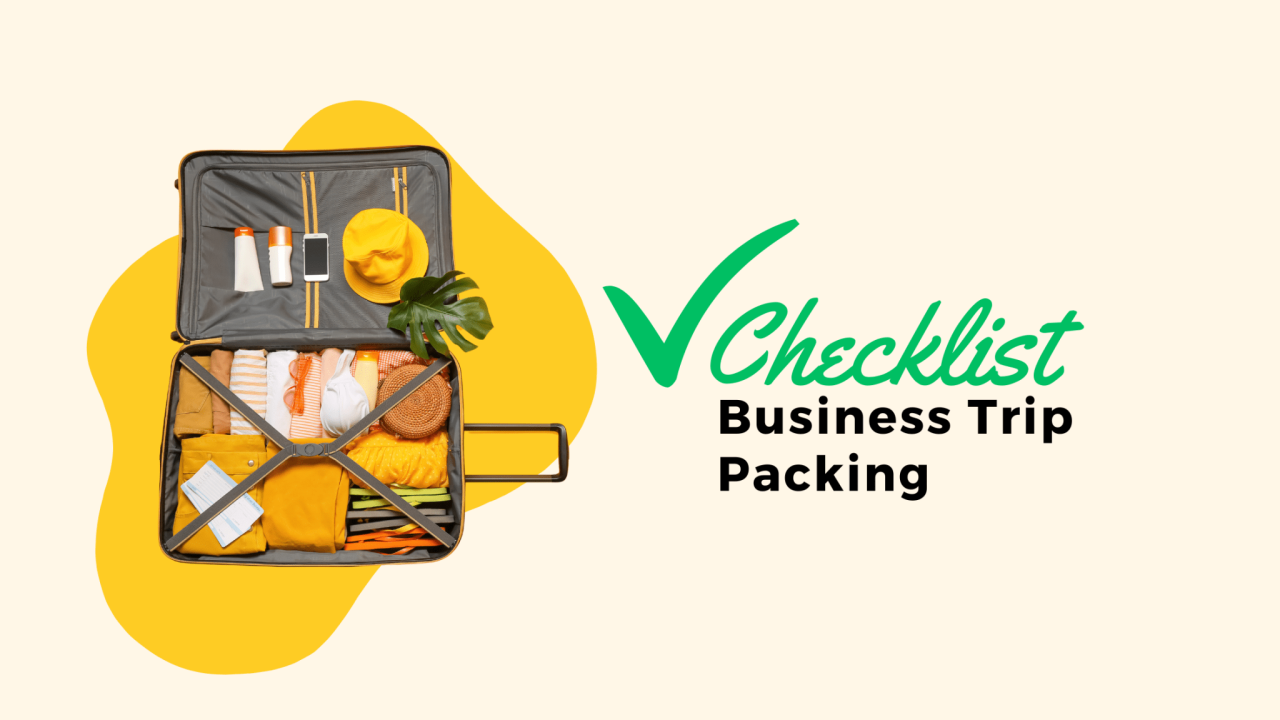What to pack for business trip checklist? Mastering the art of business travel packing is crucial for a productive and stress-free experience. This checklist tackles everything from wrinkle-resistant clothing choices and minimalist toiletries to securing essential electronics and vital business documents. We’ll cover strategies for organizing your belongings, minimizing packing space, and even navigating different climates and business contexts. Prepare for seamless travel with our comprehensive guide.
From selecting the perfect business attire suitable for various climates and events to strategizing how to pack fragile items, we’ll delve into the specifics of creating the ultimate business travel packing list. We’ll explore essential electronics and document organization, ensuring your important items are safe and easily accessible. We also address the often-overlooked aspects of business trips, including comfort items and the importance of a well-stocked first-aid kit. This comprehensive guide will help you streamline your packing process and focus on the essentials.
Clothing Essentials
Packing for a business trip requires careful consideration of your destination’s climate and the nature of your meetings. A well-chosen wardrobe ensures you project professionalism while remaining comfortable and prepared for any eventuality. This section details essential clothing items and footwear, along with fabric considerations for wrinkle resistance.
Business Attire Packing List (3-Day Trip)
This packing list provides options for various climates, emphasizing versatility and minimizing the need for excessive items. Remember to adapt based on your specific itinerary and company culture.
- Suits: Two suits are recommended – one dark-colored (navy or charcoal grey) and one lighter-colored (grey or navy pinstripe) for warmer climates. For colder climates, consider a heavier wool blend.
- Shirts: Three to four dress shirts in neutral colors (white, light blue, pale pink) are sufficient. Choose wrinkle-resistant fabrics for ease of care.
- Ties: Two to three ties in coordinating colors. Silk ties are classic, while microfiber offers wrinkle resistance.
- Underwear & Socks: Pack three sets of underwear and socks for a three-day trip.
- Belts: One black and one brown leather belt.
- Dress Shoes: See Footwear section below for detailed recommendations.
- Optional (depending on climate and events): A sweater or blazer for layering, a lightweight raincoat or umbrella, and a dressy scarf or pocket square.
Appropriate Footwear for Business Settings
Footwear is a crucial aspect of professional attire. The choice should be appropriate for the setting and reflect professionalism and comfort.
- Dress Shoes: Classic black or brown leather oxfords or loafers are the most versatile options for formal business settings. Ensure they are polished and in good condition.
- Business Casual Shoes: For less formal environments, loafers, clean sneakers (in good condition), or well-maintained leather boots might be appropriate. Avoid overly casual or worn-out shoes.
- Weather Considerations: In inclement weather, consider carrying a pair of comfortable, waterproof shoes for walking between meetings or navigating challenging conditions.
Wrinkle-Resistant Fabrics Comparison
Choosing wrinkle-resistant fabrics is key to maintaining a professional appearance throughout your trip, especially if you’re traveling with limited luggage.
| Fabric | Shirts | Trousers | Wrinkle Resistance |
|---|---|---|---|
| Cotton | Moderate | Low | Prone to wrinkling, requires ironing. |
| Linen | Low | Low | Highly prone to wrinkling, requires ironing. |
| Polyester | High | High | Excellent wrinkle resistance, often blended with other fabrics. |
| Wool (with synthetic blends) | Moderate to High | High | Good wrinkle resistance, especially with blends containing polyester or other synthetics. |
Versatile Clothing Items
Versatility is key to maximizing your packing efficiency. Select items that can be mixed and matched to create multiple outfits.
- Neutral-colored Suits: A navy or charcoal grey suit can be paired with different shirts and ties to create several different looks.
- Dress Shirts in Neutral Colors: White and light blue shirts are highly versatile and can be worn with both suits and dress pants.
- Blazer: A blazer can be worn over a shirt and trousers for a smart casual look, or layered over a suit for extra warmth.
- Dark-colored Trousers: These can be worn with different shirts and blazers for a variety of outfits.
Toiletries and Medications

Packing for a business trip requires careful consideration of essential toiletries and medications. A well-planned approach minimizes weight, maximizes efficiency, and ensures you have what you need to maintain your health and hygiene throughout your trip. Overpacking is easily avoided with a strategic approach to selecting only the necessities.
Minimizing your toiletries kit is crucial for efficient travel. Travel-sized containers are your best friend, allowing you to pack the essentials without exceeding airline liquid restrictions. Remember to check the specific regulations of your airline before you pack. Opting for multi-purpose products can further reduce the number of items you need to carry. For example, a bar of soap can serve as both body and hand soap.
Essential Toiletries for Business Travel
A minimalist toiletries kit should include only the most crucial items. This will not only save space but also reduce the risk of spills and leaks during your journey. Prioritizing essentials ensures you are prepared for daily hygiene needs without unnecessary weight.
- Toothbrush and toothpaste (travel-sized)
- Deodorant (travel-sized)
- Face cleanser (travel-sized)
- Moisturizer (travel-sized)
- Sunscreen (travel-sized, if applicable)
- Shampoo and conditioner (travel-sized, or consider solid shampoo bars for reduced liquid volume)
Recommended Toiletries for Business Travel
While not strictly essential, these items can enhance your comfort and hygiene during your trip. Consider including them based on your individual needs and the duration of your stay.
- Razor and shaving cream (travel-sized)
- Body wash (travel-sized)
- Hairbrush
- Tweezers
- Nail clippers
Optional Toiletries for Business Travel
These items are nice-to-haves but can be easily omitted if space is limited. Their inclusion depends on personal preference and the length of the trip.
- Makeup (travel-sized)
- Perfume or cologne (travel-sized)
- Hair styling products (travel-sized)
- Dental floss
- Lip balm
Essential Medications for Business Travel
Packing essential medications is paramount for maintaining your well-being throughout your business trip. This includes both prescription and over-the-counter medications. Always carry your prescriptions in their original containers with labels clearly visible. It’s advisable to carry a copy of your prescription information separately, in case of loss or damage.
- Prescription medications (with a copy of the prescription)
- Pain relievers (e.g., ibuprofen or acetaminophen)
- Antacids (for upset stomach)
- Allergy medication (if applicable)
- Motion sickness medication (if applicable)
Minimizing Spillage During Transit
To prevent spills, use leak-proof travel containers and place your toiletries in a sealed plastic bag within your luggage. Consider placing a small absorbent cloth or towel at the bottom of your toiletries bag as an added precaution. Furthermore, storing toiletries upright minimizes the risk of leaks. For liquids, tightly screw on the caps and consider using a small amount of plastic wrap under the cap as an extra layer of protection.
Electronics and Documents

A well-organized approach to packing electronics and documents is crucial for a smooth and productive business trip. Failing to adequately protect your devices or misplacing vital paperwork can significantly disrupt your schedule and potentially compromise sensitive information. This section Artikels essential steps to ensure your electronics and documents are safe, accessible, and ready for use throughout your trip.
Essential Electronics Checklist, What to pack for business trip checklist
Properly packing your electronics safeguards against damage and ensures they are readily available when needed. Consider the following checklist to ensure you haven’t forgotten anything critical.
- Laptop: Including power cord and any necessary adapters.
- Smartphone: With charger and any international adapters required.
- Tablet (optional): With charger and adapters.
- Portable charger: For convenient on-the-go charging.
- Headphones or earbuds: For calls and media consumption.
- Universal travel adapter: To accommodate various power outlets.
- USB drive: For storing important files offline.
- Camera (optional): With charger and memory card.
Document Organization and Security
Keeping your important documents organized and secure is paramount. A well-structured system prevents delays and protects sensitive information.
Consider using a dedicated travel document organizer or a sturdy folder. Organize your documents by category: Passport and visa in one section, flight tickets and itinerary in another, and any other relevant documents (hotel confirmations, meeting agendas) in separate compartments. Make photocopies of all essential documents and store them separately from the originals – one set in your luggage and another with a trusted contact back home.
Secure Data Storage During Travel
Protecting your sensitive data is crucial, especially while traveling. Employ the following measures:
Enable strong passwords and two-factor authentication on all your devices. Use encryption software to protect sensitive files stored on your laptop and USB drive. Avoid accessing sensitive information on public Wi-Fi networks. If you use cloud storage, ensure it’s a reputable service with robust security features. Consider using a VPN for enhanced security when connecting to public Wi-Fi.
Packing Electronics for Damage Prevention
A visual representation of how to pack electronics would show a carry-on suitcase with a dedicated section for electronics. Electronics are individually wrapped in bubble wrap or soft cloths. Heavier items like a laptop are placed at the bottom, cushioned by clothing. Smaller items like chargers and headphones are placed in a separate, zippered pouch to prevent tangling. The pouch itself is then nestled among clothing items to provide further protection. Fragile items such as a tablet should be placed inside a protective case before being wrapped and placed in the suitcase. The suitcase itself should be well-padded with clothing around the electronics section to absorb any impact. This method minimizes the risk of damage from bumps and drops during transit.
Business-Specific Items: What To Pack For Business Trip Checklist

Packing for a business trip requires careful consideration of items specific to your profession and the nature of your trip. Overlooking even a single crucial item can significantly impact your productivity and the overall success of your trip. This section Artikels essential business-specific items, comparing needs for different trip types and offering solutions for preventing common packing pitfalls.
The items you need will vary drastically depending on the purpose of your business trip. A sales trip will have different requirements than attending a conference, for example. Careful planning and a detailed checklist are crucial for a smooth and successful business trip.
Items for Different Business Contexts
The following list categorizes essential business-specific items based on common trip types. Remember to tailor this list to your specific needs and the nature of your engagements.
- Sales Trips: Sales brochures, product samples (packaged appropriately for transport), client gift items (consider cultural sensitivities), price lists, contract templates, portable presentation device (laptop or tablet), a reliable internet connection (consider a portable hotspot), and a fully charged power bank.
- Conferences: Business cards (plenty!), conference schedule and materials (printed or digital), comfortable shoes (for extensive walking), professional attire suitable for networking events, a notebook and pen for taking notes, and a small bag for carrying essentials during conference sessions.
- Presentations: Presentation materials (printed handouts, slides on a portable device), presentation remote, laser pointer, adapter for various presentation setups, backup copies of your presentation (on a USB drive or in the cloud), and a portable projector (if necessary).
- Negotiations: A detailed briefing document summarizing key negotiation points, legal documents (if applicable), contract templates, a calculator, and a pen for signing documents.
Sales Trip vs. Conference: A Comparison
While both sales trips and conferences involve business activities, their packing requirements differ significantly. Sales trips often require more physical materials, such as samples and brochures, while conferences focus more on networking and information gathering. The table below highlights key differences:
| Item | Sales Trip | Conference |
|---|---|---|
| Presentation Materials | Highly Important (often customized for each client) | Important (but often a general presentation) |
| Product Samples | Essential | Usually not needed |
| Client Gifts | Highly Recommended | Less common |
| Comfortable Shoes | Important (for visiting clients) | Essential (for extensive walking and networking) |
Consequences of Forgetting Business-Critical Items and Mitigation Strategies
Forgetting crucial business items can lead to significant setbacks. Missed sales opportunities, inability to deliver presentations, and strained client relationships are just some potential consequences. Proactive planning is key to avoiding such issues.
- Problem: Forgetting presentation materials can derail an important client meeting. Solution: Create multiple backups of presentations (cloud storage, USB drive, email) and always verify they are accessible before the meeting.
- Problem: Running out of business cards at a networking event limits your ability to connect with potential clients or collaborators. Solution: Pack extra business cards and consider carrying digital business cards as a backup.
- Problem: Forgetting essential documents can halt negotiations or compromise legal agreements. Solution: Keep digital copies of all crucial documents and have them accessible offline through cloud services or USB drives. Always print a hard copy as well.
Packing Fragile Business Items
Protecting fragile items like prototypes or samples during travel is crucial. Improper packaging can lead to damage, potentially resulting in significant financial losses or project delays.
- Use protective packaging materials such as bubble wrap, foam inserts, and sturdy boxes. Ensure the item is snugly fitted within the box to prevent movement during transit.
- Consider using a hard-shell case for extremely fragile items. This offers superior protection against impacts and pressure.
- Label the package clearly as “fragile” and handle with care. This will alert baggage handlers to exercise extra caution.
- If possible, carry fragile items as carry-on luggage to prevent potential damage during checked baggage handling.
Other Essentials
Packing for a business trip involves more than just the professional attire and essential documents. Often overlooked items can significantly impact your comfort, productivity, and overall trip experience. Careful consideration of these miscellaneous essentials can transform a potentially stressful journey into a smoother, more efficient one.
Miscellaneous Items for a Smooth Trip
A well-rounded packing list should include several miscellaneous items that address potential travel challenges and enhance comfort. These items, while seemingly small, can make a big difference in your overall travel experience.
- Power Adapters and Converters: Essential for charging electronics in countries with different electrical outlets and voltages. Failure to bring the correct adapter could leave you with a dead phone and laptop, severely impacting your ability to communicate and work.
- Snacks: Packing non-perishable snacks can save you time and money, and prevent hunger pangs between meals, especially during long travel days or busy work schedules. Consider energy bars, trail mix, or nuts.
- First-Aid Kit: A small, lightweight first-aid kit is crucial for addressing minor injuries or ailments. This can prevent minor issues from escalating and save you time and money on potentially unnecessary medical visits.
- Reusable Water Bottle: Staying hydrated is essential, especially during travel. A reusable water bottle allows you to refill easily and reduce plastic waste.
- Laundry Bag: A simple laundry bag helps keep dirty clothes separate from clean ones, preventing the spread of odors and maintaining organization.
Benefits of a Travel First-Aid Kit
Carrying a compact first-aid kit offers significant advantages during business trips. It provides immediate access to essential medical supplies for treating minor injuries and ailments commonly encountered while traveling, such as headaches, cuts, blisters, indigestion, or allergic reactions. This proactive approach can prevent minor issues from escalating into more significant problems, saving you time, money, and potential stress. A well-stocked kit can also provide peace of mind, allowing you to focus on your business objectives without worrying about readily available medical assistance. Consider including items like bandages, antiseptic wipes, pain relievers, anti-diarrheal medication, and any personal prescription medications.
Comfort and Convenience Items
Packing items designed for comfort and convenience can dramatically improve your travel experience and reduce stress. These small additions can contribute to a more restful and productive trip.
- Eye Mask and Earplugs: These items are invaluable for blocking out light and noise, especially in hotels with less-than-ideal soundproofing or bright streetlights. They promote better sleep and relaxation, leading to increased alertness and productivity during the day.
- Travel Pillow: A neck pillow can significantly improve comfort during long flights or car journeys, reducing neck strain and promoting better sleep.
- Comfortable Footwear: Packing comfortable walking shoes is crucial, especially if you’ll be doing a lot of walking during your trip. Blisters and foot pain can quickly derail your plans.
- Portable Charger: A portable charger ensures your devices remain powered throughout the day, eliminating the anxiety of a dead battery.
Advantages and Disadvantages of Packing Cubes
Packing cubes are fabric containers designed to compress clothing and other items, maximizing space in your luggage and improving organization.
- Advantages: Packing cubes help compress clothing, maximizing suitcase space; they keep items organized and easily accessible; they can help separate clean and dirty clothes; and they can make packing and unpacking faster and more efficient.
- Disadvantages: Packing cubes can add extra weight to your luggage; they can be expensive, especially high-quality ones; and they might not be necessary for short trips or those with minimal luggage.






